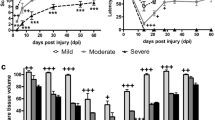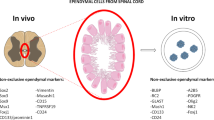Abstract
Ependymal cells (EC) in the spinal cord central canal (CC) are believed to be responsible for the postnatal neurogenesis following pathological or stimulatory conditions. In this study, we have analyzed the proliferation of the CC ependymal progenitors in adult rats processed to compression SCI or enhanced physical activity. To label dividing cells, a single daily injection of Bromo-deoxyuridine (BrdU) was administered over a 14-day-survival period. Systematic quantification of BrdU-positive ependymal progenitors was performed by using stereological principles of systematic, random sampling, and optical Dissector software. The number of proliferating BrdU-labeled EC increased gradually with the time of survival after both paradigms, spinal cord injury, or increased physical activity. In the spinal cord injury group, we have found 4.9-fold (4 days), 7.1-fold (7 days), 4.9-fold (10 days), and 5.6-fold (14 days) increase of proliferating EC in the rostro-caudal regions, 4 mm away from the epicenter. In the second group subjected to enhanced physical activity by running wheel, we have observed 2.1–2.6 fold increase of dividing EC in the thoracic spinal cord segments at 4 and 7 days, but no significant progression at 10–14 days. Nestin was rapidly induced in the ependymal cells of the CC by 2–4 days and expression decreased by 7–14 days post-injury. Double immunohistochemistry showed that dividing cells adjacent to CC expressed astrocytic (GFAP, S100beta) or nestin markers at 14 days. These data demonstrate that SCI or enhanced physical activity in adult rats induces an endogenous ependymal cell response leading to increased proliferation and differentiation primarily into macroglia or cells with nestin phenotype.
















Similar content being viewed by others
References
Abbadie C, Skinner K, Mitrovic I, Basbaum AI (1999) Neurons in the dorsal column white matter of the spinal cord: complex neuropil in an unexpected location. Proc Natl Acad Sci USA 96:260–265. doi:10.1073/pnas.96.1.260
Altman J, Bayer SA (1984) The development of the rat spinal cord. Adv Anat Embryol Cell Biol 85:1–164
Barres BA, Raff MC (1999) Axonal control of oligodendrocyte development. J Cell Biol 147:1123–1128. doi:10.1083/jcb.147.6.1123
Brown J, Cooper-Kuhn CM, Kempermann G, Van Praag H, Winkler J, Gage FH, Kuhn HG (2003) Enriched environment and physical activity stimulate hippocampal but not olfactory bulb neurogenesis. Eur J NeuroSci 17:2042–2046. doi:10.1046/j.1460-9568.2003.02647.x
Cizkova D, Rosocha J, Vanicky I, Jergova S, Cizek M (2006) Transplants of human mesenchymal stem cells improve functional recovery after spinal cord injury in the rat. Cell Mol Neurobiol 26:1165–1178. doi:10.1007/s10571-006-9093-1
Coskun V, Wu H, Blanchi B, Tsao S, Kim K, Zhao J, Biancotti JC, Hutnick L, Krueger RC Jr, Fan G, de Vellis J, Sun YE (2008) CD133 + neural stem cells in the ependyma of mammalian postnatal forebrain. Proc Natl Acad Sci USA 105:1026–1031. doi:10.1073/pnas.0710000105
Danilov AI, Covacu R, Moe MC, Langmoen IA, Johansson CB, Olsson T, Brundin L (2006) Neurogenesis in the adult spinal cord in an experimental model of multiple sclerosis. Eur J NeuroSci 23:394–400. doi:10.1111/j.1460-9568.2005.04563.x
Doetsch F, Caille I, Lim DA, Garcia-Verdugo JM, Alvarez-Buylla A (1999) Subventricular zone astrocytes are neural stem cells in the adult mammalian brain. Cell 97:703–716. doi:10.1016/S0092-8674(00)80783-7
Fernandez PA, Tang DG, Cheng L, Prochiantz A, Mudge AW, Raff MC (2000) Evidence that axon-derived neuregulin promotes oligodendrocyte survival in the developing rat optic nerve. Neuron 28:81–90. doi:10.1016/S0896-6273(00)00087-8
Gage FH (2000) Mammalian neural stem cells. Science 287:1433–1438. doi:10.1126/science.287.5457.1433
Gomez-Pinilla F, Ying Z, Opazo P, Roy RR, Edgerton VR (2001) Differential regulation by exercise of BDNF and NT-3 in rat spinal cord and skeletal muscle. Eur J NeuroSci 13:1078–1084. doi:10.1046/j.0953-816x.2001.01484.x
Horner PJ, Power AE, Kempermann G, Kuhn HG, Palmer TD, Winkler J, Thal LJ, Gage FH (2000) Proliferation and differentiation of progenitor cells throughout the intact adult rat spinal cord. J Neurosci 20:2218–2228
Johansson CB, Momma S, Clarke DL, Risling M, Lendahl U, Frisen J (1999) Identification of a neural stem cell in the adult mammalian central nervous system. Cell 96:25–34. doi:10.1016/S0092-8674(00)80956-3
Kakinohana O, Cizkova D, Tomori Z, Hedlund E, Marsala S, Isacson O, Marsala M (2004) Region-specific cell grafting into cervical and lumbar spinal cord in rat: a qualitative and quantitative stereological study. Exp Neurol 190:122–132
Ke Y, Chi L, Xu R, Luo C, Gozal D, Liu R (2006) Early response of endogenous adult neural progenitor cells to acute spinal cord injury in mice. Stem Cells 24:1011–1019. doi:10.1634/stemcells.2005-0249
Kehl LJ, Fairbanks CA, Laughlin TM, Wilcox GL (1997) Neurogenesis in postnatal rat spinal cord: a study in primary culture. Science 276:586–589. doi:10.1126/science.276.5312.586
Kondo T, Raff M (2000) Oligodendrocyte precursor cells reprogrammed to become multipotential CNS stem cells. Science 289:1754–1757. doi:10.1126/science.289.5485.1754
Koson P, Zilka N, Kovac A, Kovacech B, Korenova M, Filipcik P, Novak M (2008) Truncated tau expression levels determine life span of a rat model of tauopathy without causing neuronal loss or correlating with terminal neurofibrillary tangle load. Eur J NeuroSci 28:239–246. doi:10.1111/j.1460-9568.2008.06329.x
Lie DC, Song H, Colamarino SA, Ming GL, Gage FH (2004) Neurogenesis in the adult brain: new strategies for central nervous system diseases. Annu Rev Pharmacol Toxicol 44:399–421. doi:10.1146/annurev.pharmtox.44.101802.121631
McGee AW, Strittmatter SM (2003) The Nogo-66 receptor: focusing myelin inhibition of axon regeneration. Trends Neurosci 26:193–198. doi:10.1016/S0166-2236(03)00062-6
Mercier F, Kitasako JT, Hatton GI (2002) Anatomy of the brain neurogenic zones revisited: fractones and the fibroblast/macrophage network. J Comp Neurol 451:170–188. doi:10.1002/cne.10342
Minger SL, Ekonomou A, Carta EM, Chinoy A, Perry RH, Ballard CG (2007) Endogenous neurogenesis in the human brain following cerebral infarction. Reg Med 2:69–74
Mothe AJ, Tator CH (2005) Proliferation, migration, and differentiation of endogenous ependymal region stem/progenitor cells following minimal spinal cord injury in the adult rat. Neuroscience 131:177–187. doi:10.1016/j.neuroscience.2004.10.011
Neeper SA, Gomez-Pinilla F, Choi J, Cotman C (1995) Exercise and brain neurotrophins. Nature 373:109. doi:10.1038/373109a0
Nordlander RH, Singer M (1978) The role of ependyma in regeneration of the spinal cord in the urodele amphibian tail. J Comp Neurol 180:349–374. doi:10.1002/cne.901800211
Nunes MC, Roy NS, Keyoung HM, Goodman RR, McKhann GII, Jiang L, Kang J, Nedergaard M, Goldman SA (2003) Identification and isolation of multipotential neural progenitor cells from the subcortical white matter of the adult human brain. Nat Med 9:439–447. doi:10.1038/nm837
Palmer TD, Markakis EA, Willhoite AR, Safar F, Gage FH (1999) Fibroblast growth factor-2 activates a latent neurogenic program in neural stem cells from diverse regions of the adult CNS. J Neurosci 19:8487–8497
Palmer TD, Schwartz PH, Taupin P, Kaspar B, Stein SA, Gage FH (2001) Cell culture. Progenitor cells from human brain after death. Nature 411:42–43. doi:10.1038/35075141
Rice AC, Khaldi A, Harvey HB, Salman NJ, White F, Fillmore H, Bullock MR (2003) Proliferation and neuronal differentiation of mitotically active cells following traumatic brain injury. Exp Neurol 183:406–417. doi:10.1016/S0014-4886(03)00241-3
Schwab ME (2004) Nogo and axon regeneration. Curr Opin Neurobiol 14:118–124. doi:10.1016/j.conb.2004.01.004
Spassky N, Merkle FT, Flames N, Tramontin AD, Garcia-Verdugo JM, Alvarez-Buylla A (2005) Adult ependymal cells are postmitotic and are derived from radial glial cells during embryogenesis. J Neurosci 25:10–18. doi:10.1523/JNEUROSCI.1108-04.2005
van Praag H, Kempermann G, Gage FH (1999) Running increases cell proliferation and neurogenesis in the adult mouse dentate gyrus. Nat Neurosci 2:266–270. doi:10.1038/6368
Vanicky I, Urdzikova L, Saganova K, Cizkova D, Galik J (2001) A simple and reproducible model of spinal cord injury induced by epidural balloon inflation in the rat. J Neurotrauma 18:1399–1407. doi:10.1089/08977150152725687
Weiss S, Dunne C, Hewson J, Wohl C, Wheatley M, Peterson AC, Reynolds BA (1996) Multipotent CNS stem cells are present in the adult mammalian spinal cord and ventricular neuroaxis. J Neurosci 16:7599–7609
Yamamoto S, Yamamoto N, Kitamura T, Nakamura K, Nakafuku M (2001) Proliferation of parenchymal neural progenitors in response to injury in the adult rat spinal cord. Exp Neurol 172:115–127. doi:10.1006/exnr.2001.7798
Yamashita T, Fujitani M, Yamagishi S, Hata K, Mimura F (2005) Multiple signals regulate axon regeneration through the nogo receptor complex. Mol Neurobiol 32:105–112. doi:10.1385/MN:32:2:105
Zai LJ, Wrathall JR (2005) Cell proliferation and replacement following contusive spinal cord injury. Glia 50:247–257. doi:10.1002/glia.20176
Acknowledgments
We express our thanks to Maria Spontakova for her great and valuable assistance in the immunocytochemical analysis. This study was supported by financial grants: APVV 51-002105, VEGA 2-0019-08, VEGA 1-0674-09, APVV/0682/07, AV0Z50450515 (Research Concept of IAPG), MEB0808108, and APVV 0045-07.
Author information
Authors and Affiliations
Corresponding author
Rights and permissions
About this article
Cite this article
Cizkova, D., Nagyova, M., Slovinska, L. et al. Response of Ependymal Progenitors to Spinal Cord Injury or Enhanced Physical Activity in Adult Rat. Cell Mol Neurobiol 29, 999–1013 (2009). https://doi.org/10.1007/s10571-009-9387-1
Received:
Accepted:
Published:
Issue Date:
DOI: https://doi.org/10.1007/s10571-009-9387-1




